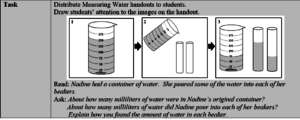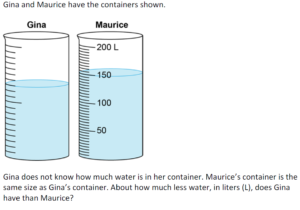Measure and estimate liquid volumes and masses of objects using standard units of grams (g), kilograms (kg), and liters (l). Add, subtract, multiply, or divide to solve one-step word problems involving masses or volumes that are given in the same units.
[divider] [/divider] Students are able to…
- Estimate and measure liquids using liters.
- Estimate and measure objects to determine their mass in grams/kilograms.
- Solve word problems and use appropriate units of metric capacity.
[divider] [/divider] Students are able to…because teachers:
- Provide hands-on opportunities for students to explore mass and volume to build an understanding of metric capacity.
- Model precise vocabulary (metric, liquid, volume, gram, kilogram, etc.)
- Pose tasks where students use all four operations to solve one-step word problems.
[divider] [/divider] Questions to ask students:
- Find an item in the classroom that would hold about a liter and explain how you know.
- Sample answer that indicates understanding: My thermos holds about 1 liter of water. I know because it holds two bottles of water and two bottles of water is about 1 liter.
- Find an item in the classroom that weighs close to a gram.
- Sample answer that indicates understanding: A small paper clip weighs close to a gram.
- Ask the student, if a pencil has a mass of about 5 grams, what is the mass of 4 pencils?
- Sample answer that indicates understanding: 20 grams because each pencil is 5 grams and I counted by 5’s for each of the 4 pencils
[divider] [/divider] FSA Notes
Cognitive Complexity Level: 2 – Basic Application of Skills and Concepts
Achievement Level Descriptors:
2- measures liquid volumes and masses of objects using models and standard units
3- estimates liquid volume and mass of objects using standard units; solves one-step word problems involving any of the four operation
4- [intentionally left blank]
5- [intentionally left blank]
Assessment Limits:
Items may not contain compound units such as cubic centimeters (cm³) or finding the geometric volume of a container.
Items may not require multiplicative comparison (e.g., “times as much/many”).
Unit conversions are not allowed.
Units are not limited to grams, kilograms, and liters.
[divider] [/divider] Additional Resources:
Additional in depth content knowledge
Blog Post: Connecting Academics and Parents- Measurement 3rd Grade
Video: Add and Subtract Liquid Volumes
[divider] [/divider] Sample Formative Assessment Task:

